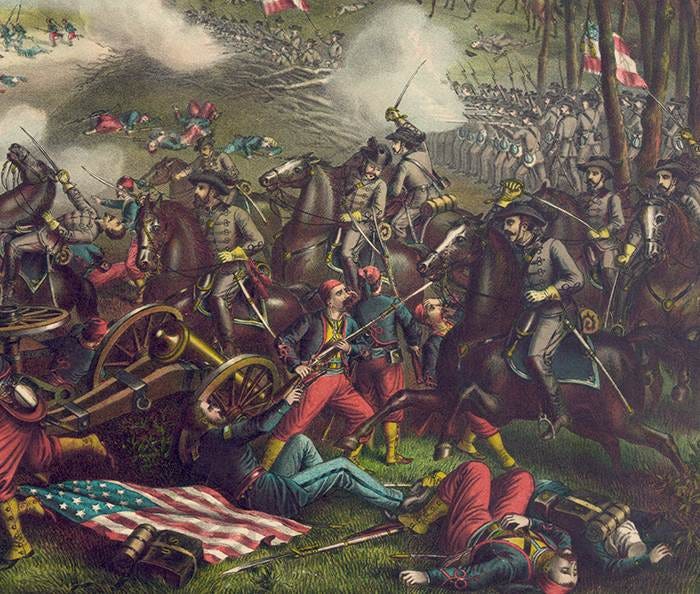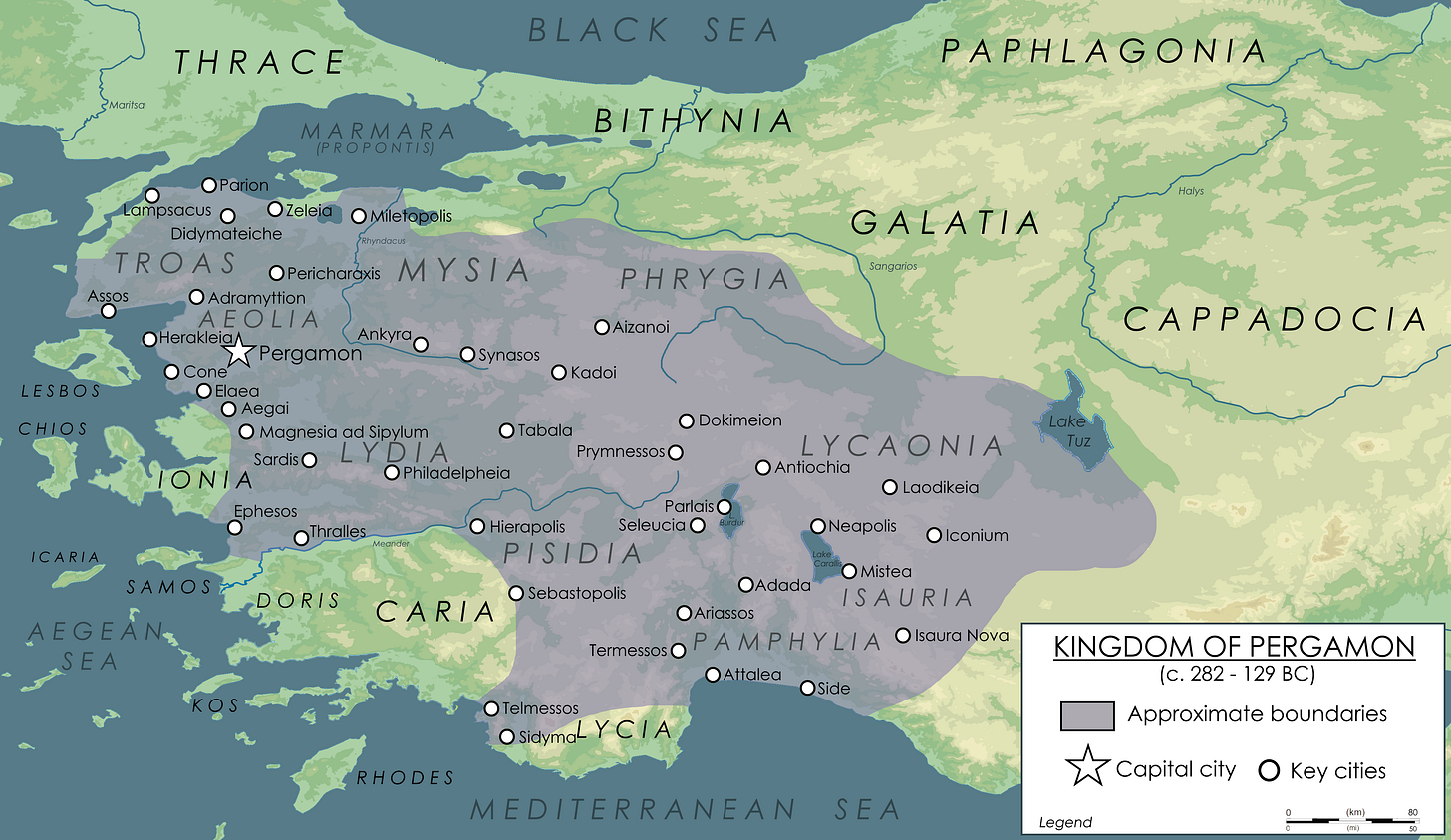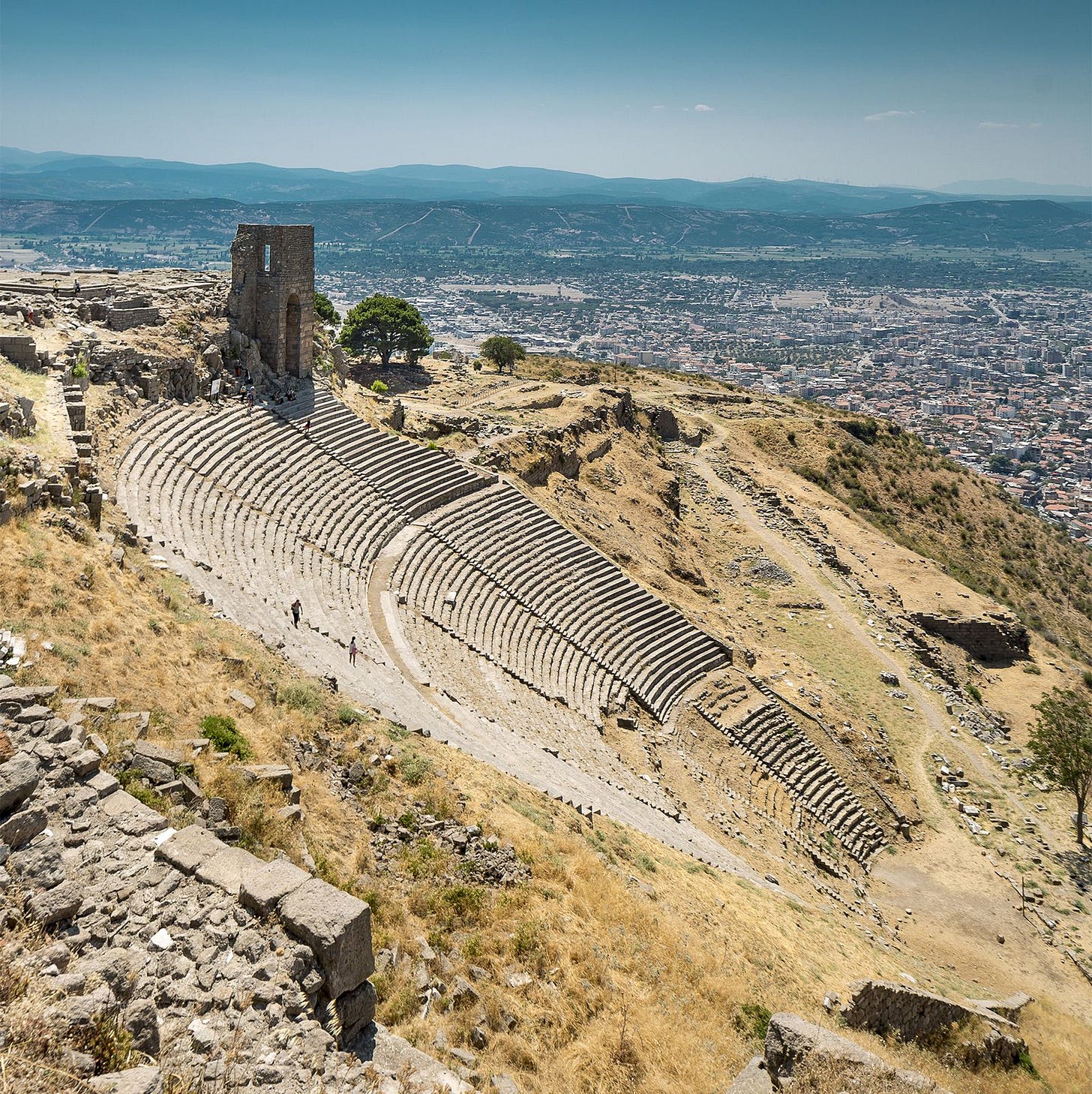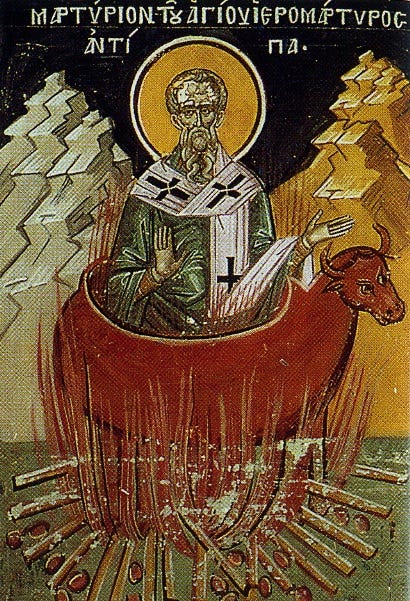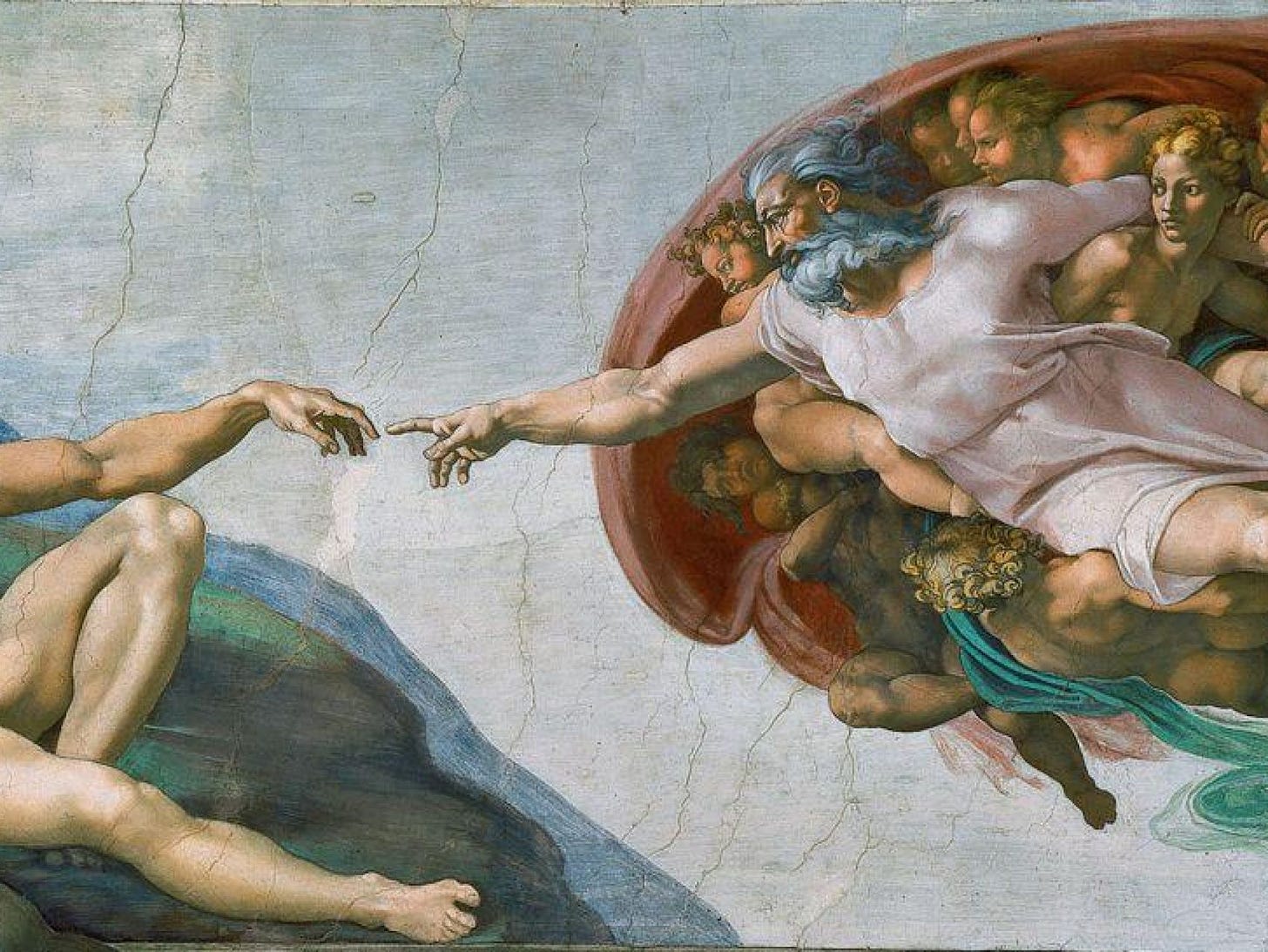Spiritual Warfare and the Early Church of Pergamum
a sermon reflection on Revelation 2:12-17
This is the second of two sermon reflections for Sunday October 19th. This essay reflects on Pastor Jeremy Macdonald’s third sermon in his Book of Revelation sermon series.
If you appreciate these sermon reflections or any of my writing, please feel free to drop a tip in the tip jar, aka Buy Me a Coffee! Much appreciated.
image: Detail from lithograph of the first Battle of Bull Run by Kurz & Allison, Chicago, 1889 (Library of Congress)
Revelation 2:12-17 :: The Message to Pergamum
12 ‘And to the angel of the church in Pergamum write: These are the words of him who has the sharp two-edged sword:
13 ‘I know where you are living, where Satan’s throne is. Yet you are holding fast to my name, and you did not deny your faith in me[a] even in the days of Antipas my witness, my faithful one, who was killed among you, where Satan lives. 14 But I have a few things against you: you have some there who hold to the teaching of Balaam, who taught Balak to put a stumbling-block before the people of Israel, so that they would eat food sacrificed to idols and practise fornication. 15 So you also have some who hold to the teaching of the Nicolaitans. 16 Repent then. If not, I will come to you soon and make war against them with the sword of my mouth. 17 Let anyone who has an ear listen to what the Spirit is saying to the churches. To everyone who conquers I will give some of the hidden manna, and I will give a white stone, and on the white stone is written a new name that no one knows except the one who receives it.
For readers wishing to delve into the Patristics commentary, here’s the link to the passage in the Catena Bible online.
Pastor Jeremy began his sermon with a mention of the Battle of the Bull Run Picnic. At the first conflict of the American Civil War, society people decided to make a picnic of the event, so they followed the Union Army onto the battlefield to meet the Confederate Army, expecting an easy victory for the Union Army. The battle proved much more involved, not at all the easy bloodless victory anticipated. The people underestimated the gravity of the situation. Union Army didn’t prepare for the treacherous battle they would face.
Reader, what if we could see ourselves on a very treacherous battlefield of modern spiritual warfare? Did we prepare for the battle? Or did we underestimate the enemy we would face and decide we can kick back and have a picnic?
This week’s passage focuses on spiritual warfare, serves as a Template for spiritual warfare.
This week’s passage features the Church of Pergamum. The word Pergamum comes from the Greek word for citadel or height — the city’s acropolis sat at the top of an hill. The city had a reputation for producing high quality parchment, leading to a secondary etymology related to parchment. The word parchment comes from the Latin word pergamena, which means of Pergamum.
image: Pergamum’s theatre in the Acropolis
Pergamum dominated the ancient world, and the Altar of Pergamum made the list of ancient wonders of the world. Satan’s throne in this week’s Revelation passage refers to the Altar of Pergamum.
Pergamum served as a major centre for the imperial cult of emperor worship. The cult of Caesar demanded that all declare Caesar as their Lord. Pergamum also served as a major centre of widespread idol worship, having worship sites dedicated to Zeus, Athena, Dionysus, and Asclepius.
The worship of Dionysius made Pergamum a centre of debauchery and revelry. The cult of Asclepius drew people from across the empire to the temple of Asclepius for healing, in which the god of healing took the form of a serpent.1 Readers might remember the biblical story in Numbers 21:8-9 of Moses and the serpent as a symbol of G-d’s healing. And readers might have familiarity with the Orthodox tradition of depicting Christ on the cross in a serpentine manner. So, the snake as a symbol of healing has a lengthy history.
image: the martyrdom of Antipas of Pergamum
The mention of Antipas in verse 13 refers to Saint Antipas of Pergmum, an early church bishop living in Pergamum who faced spiritual warfare in his Christian life. Antipas’s refusal to renounce his believe in Jesus resulted in his execution. The Roman emperor (Herod or Domitian) ordered Antipas to be burned alive inside a hollow bronze bull. Antipas would invite people into his home and heal them in the name of Christ and this enraged the emperor because it subverted the idol worship of the time.
Pastor Jeremy mentioned a few examples of spiritual warfare in the Bible —the story of Job, Peter (the get behind me Satan passage), Ephesus, and Jesus in the wilderness tempted by Satan before His ministry.
What kind of template can we draw from this passage to engage spiritual warfare?
Awaken to Reality
Battle with Discernment
Conquer with Truth
Awaken to Reality
“There are two equal and opposite errors into which our race can fall about the devils. One is to disbelieve in their existence. The other is to believe, and to feel an excessive and unhealthy interest in them. They themselves are equally pleased by both errors and hail a materialist or a magician with the same delight.” — Screwtape letters
When we underestimate the enemy in any battle, we fall into one of the biggest pitfalls of spiritual warfare. When we make light of our enemy and decide to make a picnic on the battlefield of war we can easily fall into defeat. Charles Taylor writes about this in his book—the modern secular age having lost its enchantment; the world before the enlightenment had a quality of enchantment that we now lack. We have moved from a society governed by a mandatory supernatural to one in which it’s become optional. In the post-enlightenment era, we have subordinated the supernatural and hidden realms to the natural world and the science we’ve created to explain it. The Enlightenment has cultivated a disenchanted world—stripped away spiritual mysticism. Taylor says that disenchantment has left people feeling as though there’s more than we acknowledge or see, that we’re missing the unseen realm. Do humans need the hidden realm? Do we need to believe in something larger and more mysterious than ourselves? Reader, it would seem so.
In 2 Corinthians 10:3-4, Paul reminds the Corinthians that “…we do not wage war according to human standards; 4 for the weapons of our warfare are not merely human.” And in Ephesians 6:12, Paul writes that “our struggle is not against enemies of blood and flesh.” So, awakening reality means to acknowledge that the dangers we face go beyond the physical and flesh-based material world, it goes to ideas that seed in our minds and hearts.
Battle discernment
Revelation 2:14-15 mentions Balaam, that’s a reference to the Torah. In Numbers 31:16, the story of Balaam involves corruption through compromise — by enticing or counselling the Israelites to sin. In the face of spiritual warfare, we definitely need to exercise discernment. In ancient Pergamum society, pagan idolatry frequently involved parties/orgies, a seduction that Christians struggled to resist, on pain of persecution and even death. When we compromise we run the risk of falling into sin. The accuser, Satan, works by deception. Deception becomes a stumbling block, or a trap, think about traps in the context of hunting.
How does excuse making lead to our compromise and justification of our sins? No one plans to ruin their lives, it’s a subtle process, one that becomes a pattern of behaviour. Think of how a person falls into the bottomless pit of addiction. It’s an innocent beginning: just this once … ok one more time won’t hurt … next thing you know you’re in that trap, unable to escape without help. Reader, remember the temptation in the Garden of Eden? The serpent places a question mark where G-d has put a period, he reinterprets g-d’s word. We must practise discernment to stay in the light of G-d’s truth. That requires us take our thoughts captive and line them up with the word of G-d.
Conquer with Truth
In Ephesians 6:11, Paul urges the Ephesians to “put on the whole armour of God, so that you may be able to stand against the wiles of the devil.” In ancient culture, a belt held a loose and draped outfit together. So, what if we thought of truth as a belt holding the outfit of our existence together? Truth in G-d holds our life together—what if we could see the Bible as living and active? For Christians, how can we see The Word in the living and active Bible.
What if we could see spiritual warfare as private and subtle, as opposed to not militant and aggressive? Can we redefine the truth of Christ? Can we apply truth and conquer falseness with grace and love?
image: creation of Adam, by Michaelango, c. 1512, Sistine Chapel
The Genesis creation myth (1:27) says G-d made humans in his image, “And God created humankind in the divine image, creating it in the image of God—creating them male and female.” In 1 Corinthians 6:18-20, Paul speaks about distortions of sexual. He asks the Corinthians, “… do you not know that your body is a temple of the Holy Spirit within you, which you have from God, and that you are not your own? 20 For you were bought with a price; therefore glorify God in your body.”
How have we allowed secular culture to draw us away from the truth? Who has allowed themselves to fall into corruption through compromise, mistakenly thinking their compromise a moral goodness? Readers no doubt have familiarity with gender ideology and the way it distorts truth by insisting men can become women, and forcing us to pay homage to that imperial cult. The cult of identity has replaced the cult of Caesar, hasn’t it?
To whom do we bow, in worship? Do we bow to Caesar? Do we bow to Asclepius? Do we bow to G-d? That’s a choice we must each make for ourselves. And as for others, we must approach them with compassion and respect for their free will— call in, as opposed to call out, inviting to healing and offer the option of the grace of repentance.
A serpent entwined around a rod serves as the symbol of Asclepius, and it’s often confused with the Caduceus, the symbol of Hermes. Both symbols have a connection to modern day medical symbology.



